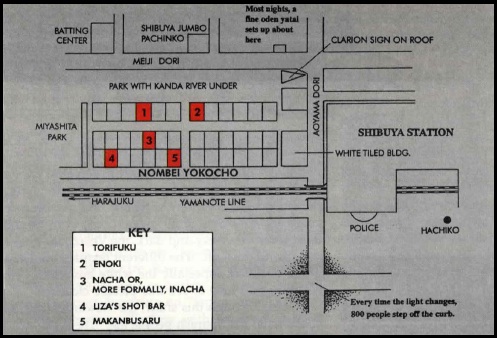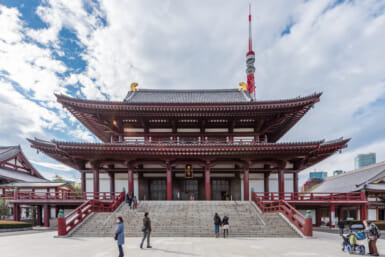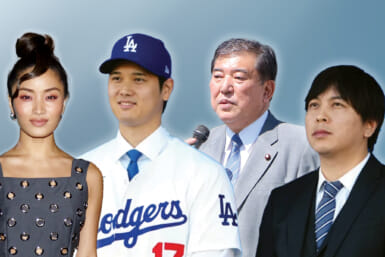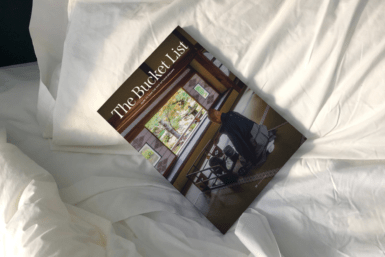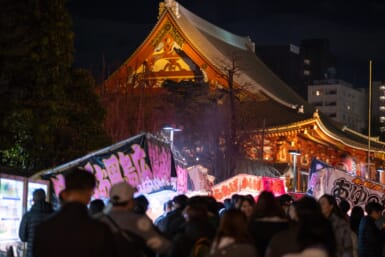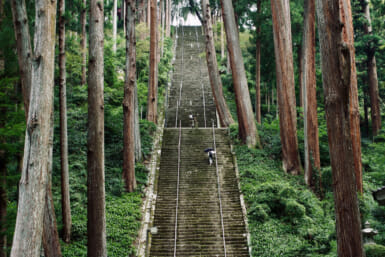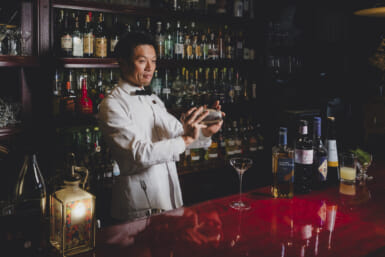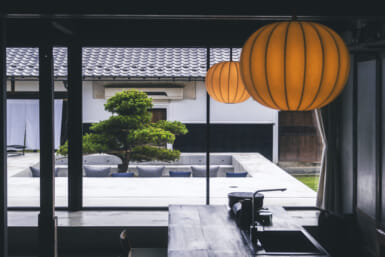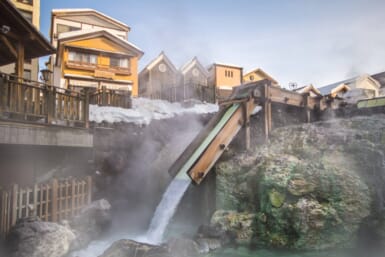Reel down to Shibuya’s Nombei Yokocho!
by Rick Kennedy
Cozy little drinking places with seats for only five or six reasonably svelte customers, looked after by an expansive character who is a bit of a renegade, are an old Tokyo tradition. It’s to places like this that a large portion of the (male) population repairs at the end of the day to wash down a few skewers of yakitori with a flask or two of sake, while discussing strategies and building alliances. As the clientele settles in over the years, these places tend to develop their own niche, so that one will find itself home to political journalists and cartoonists, another will tend to attract people interested in building and flying experimental aircraft, and another will cater to mountaineers. In this way, they are like little clubs.
Unfortunately, very unfortunately, these little places are now under terrific pressure, as the economics of running an establishment with just six seats in a city whose real estate is worth as much as all the real estate in the U.S. makes no sense at all. We’ve already lost “The Street of Dreams” in Shimbashi to the developers and Shinjuku’s wonderful Golden Gai area is under heavy attack.
Luckily, Nombei Yokocho (“Drunkards’ Alley”) just across the street from Shibuya Station seems safe for the moment as the 39 little places that make it up are jammed together on a very narrow strip of land bounded on one side by the Yamanote Line and on the other by the cemented-over Kanda River, an awkwardness which has so far deflected the interest of the developers.
An evening in one of the little places in Nombei Yokocho is bound to be memorable. You should be aware that not all of these places are eager to welcome foreign faces, especially early in the evening, because they feel foreigners talking their peculiar languages will be difficult to communicate with and may put other customers off. As a matter of protocol, therefore, it is probably not a good idea to come with a fellow foreigner and spend the whole evening talking to each other. It’s cooler as well as more of an adventure if on your first visit you go alone and do more listening than talking. Then the next time you drop in, you’ll be welcomed as a member in good standing.
There are five places in Nombei Yokocho which you will find particularly congenial and at which will be welcome right from the start, if only as a curiosity. None of them is expensive; you’ll find it hard to spend as much as ¥3,000.
1. Tori Fuku (“Happy Bird”)—The taciturn Mr. Murayama roasts over charcoal the complete yakitori repertoire, including tamago no michi (the bird’s unlaid eggs), sunagimo (gizzard) and tebasaki (wings). His superb sasami (breast) comes wrapped around a shiso leaf and is eaten dipped into grated daikon thickened with a quail’s egg and the meal is finished off with a cup of herbal homemade potato soup, the perfect grace note. Ms. Murayama (sister) presides over the annex upstairs, which is reached by a staircase as narrow as a ladder. Tori Fuku was established 40 years ago by Mr. Murayama’s father who started the business using a yatai, a street cart. Such is the rapport built up by the senior Mr. Murayama, his qld customers still drop by, often to introduce their grandsons.
2. Liza’s Shot Bar. Liza’s about 28 years old and is thus the new wave of Nombei Yokocho proprietors. Although she’s never been out of the country, she speaks perfect English. There’s reggae and soul spilling out of the cassette player on the bar. She serves moussaka, taramo salad and French bread for ¥1,000, and when she’s in the mood, she’ll whip up a batch of frozen Margaritas. Decorations are in a whatever-will-be-will-be mode, with graffiti and tiger skins and an almost critical mass of clutter. The house phone is cordless.
3. Enoke. Chizuko-san, Enoki’s pert and lively proprietor, is so open and jolly you will feel at home immediately. She holds her ground in the face of the banter with the assurance of a stand-up comedian. In tribute, all her patrons, from the justice of the Supreme Court on down, call her “Mama.” This is a high-class place. The keep bottles are malt whiskey, the plates are chosen with care and Chizuko is an imaginative cook on her single gas burner behind the counter. Currently, she’s on a Spanish kick and is experimenting gleefully with garlic.
4. Nacha has been presided over for the past 35 years by Ms. Matsumoto. She wears a crisp kimono and drinks whiskey while you drink sake so that as the evening unwinds, it’s a race to see who can get loosest fastest. In a very simple setting, Ms. Matsumoto serves things like boiled new baby potatoes, matsutake mushroom rice in season, with her own pickles in support. Ms. Matsumoto likes to watch television, so the conversation is mostly counterpoint to what’s on the screen. Identify Nacha by its rope noren out front.
5. Makanbusaru. Setsuko (65) has been running this place for around 30 years. Its name commemorates the town in Indonesia where her sister lived during the war. There’s a map of Indonesia on the wall and a mobile of Japanese fighter planes. This is a place for people with a history behind them to come and reminisce over sake and shochu. Setsuko’s offerings are simple: tofu, horenso (spinach), natto. Toward the end of the evening, an ex-corporal of the now-defunct Imperial Army, a sweet old guy, might drop in to play a few requests for the songs he specializes in, songs dripping with nostalgia, on his guitar. Other places shoo him away, but he’s at home here.
It’s hard to imagine a more Tokyo adventure than a prowl through Nombei Yokocho.
But the night is still young. Up Meiji Dori, just past Shibuya Jumbo, one of Tokyo’s classiest pachinko parlors, is the Batting Center. Maybe you should come to the Batting Center before going to Nombei Yokocho, but now you may have a certain brazen self-confidence that you didn’t have earlier in the evening. Still, it’s probably best first to take up a stance at Position 5 on the first floor. Here the ball comes at you at a comparatively leisurely 50 kilometers per hour. If you find that you can get a handle on this ball, you might want to move up. The top speed of a Batting Center pitch is 130 kph—the Big Leagues. Nine balls cost ¥300.
On the way back to Shibuya Station, you’ll pass a fine oden yatai and at the corner, if you look up, you’ll see the most complex neon sign in the world (see box). Clarion, a manufacturer of car stereos, decided not to fritter their advertising budget away on the usual newspapers and magazines, but to stake the whole thing on a single magnifice neon sign. The one described below.
The Clarion Sign: a visual opera in four acts
Act I—A foreground is established by sweeping from left to right, then from bottom to top, in a sharply graded perspective in yellow, white and blue neon, then in a combination of these colors.
Act II—A tall red skyscraper shoos up on the far horizon, then another, then another, until in the space of about five seconds, a whole New York skyline of 50 buildings of all sizes and shapes has been created. This cityscape glows evilly for a second before . . .
Act III—… a bird swoops in from the left. You follow it as it flies across the horizon and toward the city, its wing flapping lazily, growing smaller and smaller until . . .
Act IV—… you see the white bird in the canyons of the city. Red buildings flash by on both sides faster and faster. The scene becomes frantic, psychedelic, then calm as the corridor of buildings becomes cathedral-like. Then, as finis, the word “Clarion” appears under the bird.
The cycle takes about 20 seconds. One feels it should be set to music. Organ, perhaps.

